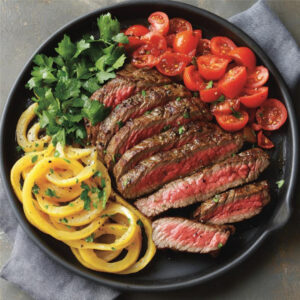Last Updated on December 2, 2019
Beef dish names can be so odd.
London broil is just another example of the beef industry’s propensity for attaching names to cuts of meat that are confusing, don’t quite fit, or, sometimes, are quite unappetizing.
The Delmonico steak, for instance, was supposedly “invented” at Delmonico’s in New York; but the exact cut of beef that was used is often debated. Steak lovers aren’t sure whether a Delmonico is boneless ribeye steak, a bone-in top loin steak, or a boneless top loin strip steak. The Denver steak was “discovered” in the last decade, and its name comes more from the work of a marketing team than to any direct connection to the Mile-High City. And don’t get me started on the contrast between the tender and tasty flat iron steak and the old, hunk of metal used for straightening clothes from which its name is derived.
But London broil might be in a class of its own when it comes to its unique (and misleading) name. The cut — or cooking method to be more precise — has no connection to the capital of England, and, these days, it is rarely broiled.
A North-American Treat
The most mind-blowing part about London broil is that it is completely unheard of in, of all places, London. The name may be a bit of the same trickery used with the Denver steak.
As far as most people can gather, London broil was first cooked in Philadelphia. The history behind the name is lost to time, but the best theory for its relation to the city of London is that the name was meant to add status — and an association to a British sensibility and European economic prestige.
London broil can be both a cut of beef and a way to prepare and cook a steak.
In the late twentieth century, it would be commonplace to go to the grocery store butcher and get a “London broil,” which would be one of the more inexpensive cuts. Likely, the steak consumers of that era were getting a flank steak — which didn’t have the same popularity as it does these days as a favorite for fajitas, steak sandwiches, and other such dishes. The proper, regal sounding name may have been meant to appeal to consumers who might have perceived the affordable steak as a way to rise above their means.
The steak was likely brought home and cooked directly under the broiler in the oven until a crispy crust formed. Maybe some salt and pepper was a part of the cooking process. It was then sliced and served.
Many remember the dish as tough or flavorless. Those unfortunate food memories are likely due to the cooking practice of broiling on high heat as well as the lack of a critical step that is used to make London broil today: The marinade.
Many reflect fondly — and still enjoy to this day — a good London broil, we’ll share some best practices below to ensure you can delight in this delicious steak as well.
You just won’t ever find the steak in the city of London because it simply does not exist there; it is purely the product of the United States.
What Exactly is London Broil?
According to most accounts, those who remember getting London broil from the supermarket butcher recall it being a flank steak, or, sometimes, a thick piece of flank steak. (While it would make sense for skirt steak to be used as London broil due to its similarity to flank steak, there don’t seem to be many instances of that occurring.)
ButcherBox grass-fed “London broil” comes from one of the best cuts from the round primal of a cow; it is a great steak found in the rear leg section that doesn’t produce many good cuts of beef. According to ButcherBox Head Chef Yankel Polak, the 6-ounce cut that can be found in a monthly ButcherBox is “the most flavor of all the round steaks.”
You may also discover that various beef cuts such as the top round, the bottom round, sirloin steak tip, chuck shoulder, or chuck steak is also labeled as “London broil.”
The main reason for this is that London broil is most often a cooking method that involves marinating a less tender cut, pan-broiling or grilling the steak and then slicing it — across the grain — into thin slices.
What many people love about London broil is its flavor. And while previous generations may have skipped a key step, it is the marinating of the beef that explains its popularity.
Whether a flank steak or round steak, when marinated right, it is a great dish. There is no best way to marinate a London broil, but combinations of soy sauce, garlic, olive oil, balsamic vinegar, mushroom sauce, red wine, rosemary, and other spices work best for the marinade.
The marinade can also be poured over the steak after cooking for added flavor. Chef Yankel thinks London broil is best served with a thick steak sauce or and easy-to-make au jus.
Don’t forget to CUT AGAINST THE GRAIN. If you don’t follow this essential step, you can quickly turn what would have been a tender steak into a tough cut — because you didn’t break the steak’s connective tissue — that is not easy to eat.
How to Cook a London Broil
As the name implies, a London broil is supposed to be oven-broiled in a shallow pan. Broiling has long been the traditional method of preparation.
However, these days, London broil is more likely to be grilled on an open flame over high heat than thrown into the oven. The reason? It may be that people feel they have more control over the doneness of their steaks when cooking on a grill.
The current popularity of grilling over an open flame rather than under a broiler may have to do with remembrances of eating a dried out, flavorless steak in the past. When cooked right, you can get a melt-in-your-mouth London broil cooked in the oven. It requires a diligent eye on cooking time and a great marinade.
If cooking on a grill, Chef Yankel suggests preheating until the surface of the grill is extremely hot. Right before putting the steak that has already gone through the marinating process on the open flame, he suggests quickly rubbing an olive oil-soaked cloth over it.
For a medium-rare London broil, Chef Yankel says to cook the room temperature steak on the hottest part of the grill for 3 minutes per side, rotating the steak on the grates 90 degrees each minute and a half. This process will give the steak a nice sear. (You can also get a great sear by using Chef Yankel’s pan-frying method as well.)
Then put the steak on the cooler section of the grill and let it cook for four more minutes on each side. Use a meat thermometer to make sure that the thickest part of the steak reaches 120° F. Another key step is to make sure the steak rests for between six to ten minutes so that it cooks evenly and the flavorful juices are distributed throughout.
Again, make sure to cut against the grain when slicing. And enjoy!

Ingredients
- 4 ea ButcherBox Top Round London Broil
- 2 c butternut squash ‘noodles’
- 1 c cherry tomatoes sliced in half
- 2 Tbsp olive oil extra virgin
- 4 cloves garlic thinly sliced
- ½ tsp chili flakes
- 1 Tbsp parsley chopped
- salt and pepper to taste
Marinade
- 6 cloves garlic minced
- 1 lemon zest
- 4 Tbsp parsley chopped
- 2 Tbsp thyme chopped
- 2 Tbsp rosemary chopped
- ¼ c olive oil extra virgin
- 1 lemon juiced
Instructions
- Mix all marinade ingredients in a bowl. Coat the steaks thoroughly and refrigerate for at least 30 minutes or overnight. Let steaks sit at room temperature for 30 minutes before cooking
- Preheat oven to 375°F.
- Preheat cast-iron skillet or grill pan on medium-high heat.
- Sear Top Round London Broils on all 6 sides, for 1-2 minutes per side. Transfer to sheet pan and finish in oven. Roast for 5-8 minutes, or until thermometer inserted in thickest part reads 120°F. Let rest for at least 8 min before slicing.
- Preheat non-stick sauté pan to medium heat, and add olive oil. Once oil is hot, add garlic. When garlic begins to brown, add squash noodles and tomatoes and sauté for 3-5 minutes, or until noodles have softened.
- Add lemon juice, chili flakes, parsley and salt and pepper. Continue to sauté until mixed. Serve with sliced steak and enjoy!
Dennis Keohane is a writer, editor, and former Editorial Director for ButcherBox with a passion for storytelling and food. Combining his love for high-quality ingredients with engaging narratives, he crafts content that inspires home cooks to explore new flavors, techniques, and the joy of cooking.



